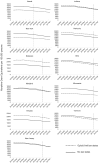Opioid Prescribing Laws Are Not Associated with Short-term Declines in Prescription Opioid Distribution
- PMID: 31365095
- PMCID: PMC7060402
- DOI: 10.1093/pm/pnz159
Opioid Prescribing Laws Are Not Associated with Short-term Declines in Prescription Opioid Distribution
Abstract
Objective: To determine whether the adoption of laws that limit opioid prescribing or dispensing is associated with changes in the volume of opioids distributed in states.
Methods: State-level data on total prescription opioid distribution for 2015-2017 were obtained from the US Drug Enforcement Administration. We included in our analysis states that enacted an opioid prescribing law in either 2016 or 2017. We used as control states those that did not have an opioid prescribing law during the study period. To avoid confounding, we excluded from our analysis states that enacted or modified mandates to use prescription drug monitoring programs (PDMPs) during the study period. To estimate the effect of opioid prescription laws on opioid distribution, we ran ordinary least squares models with indicators for whether an opioid prescription law was in effect in a state-quarter. We included state and quarter fixed effects to control for time trends and time-invariant differences between states.
Results: With the exception of methadone and buprenorphine, the amount of opioids distributed in states fell during the study period. The adoption of opioid prescribing laws was not associated with additional decreases in opioids distributed.
Conclusions: We did not detect an association between adoption of opioid prescribing laws and opioids distributed. States may instead wish to pursue evidence-based efforts to reduce opioid-related harm, with a particular focus on treatment access and harm reduction interventions.
Keywords: Law; Opioids; Pain Management; Policy; Prescribing.
© 2019 American Academy of Pain Medicine. All rights reserved. For permissions, please e-mail: journals.permissions@oup.com.
Figures
References
-
- Parker AM, Strunk D, Fiellin DA.. State responses to the opioid crisis. J Law Med Ethics 2018;46(2):367–81. - PubMed
-
- Kolodny A, Courtwright DT, Hwang CS, et al. The prescription opioid and heroin crisis: A public health approach to an epidemic of addiction. Annu Rev Public Health 2015;36(1):559–74. - PubMed
Publication types
MeSH terms
Substances
Grants and funding
LinkOut - more resources
Full Text Sources
Miscellaneous



